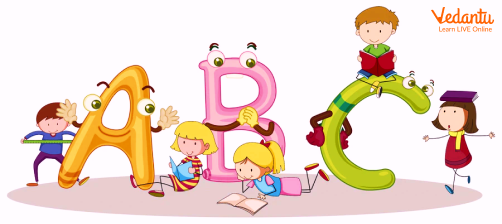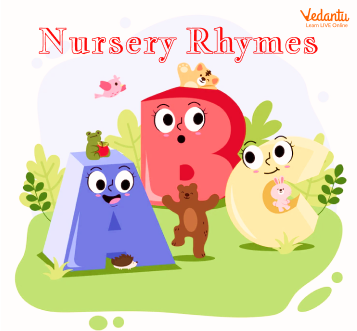




Top 10 Enjoyable Ways for Kids to Learn the English Alphabet
Kids study English with the English Alphabet. This is the only preliminary learning that a kid will encounter who is learning English for the first time. Learning A, B, C is definitely fun. It is even merrier when we sing the rhymes of A B C.
In this article, we are going to learn the English alphabet. Also, we are going to sing the rhymes of A B C together.
Alphabets of English

English Alphabets
In the English Alphabet, there are 26 letters in total. In alphabetical order, the letters are as follows:
a b c d e f g h i j k l m n o p q r s t u v w x y z
The Vowel and Consonant Letters
The five letters that are considered as vowels of the English alphabet are a, e, i, o, and u while the remaining 21 letters are known as consonants. We can write these English Alphabet in small as well as in capital letters. In the next section, we will see the capital and small letters of the English alphabet.
Small and Capital Letters
The chart below shows the capital and the small letters in the English alphabet.
The ABC Rhymes

A B C Rhymes
Now, let us sing the A B C rhymes.
A-B-C-D-E-F-G
H-I-J-K-LMNOP
Q-R-S
T-U-V
W and X
Y and Zee
Now I know my “ABCs”
Next time won’t you sing with me?
A B C Apple Pie Rhymes
Says A,
give me a good large slice,
Says B,
a little bit, but nice,
Says C,
cut me a piece of crust, Take
it, says D,
it’s dry as dust,
Says E,
I’ll eat it fast,
I will, Says F,
I vow I’ll have my fill,
Says G,
give it me good and great, Says H, a little bit I hate,
Says I,
it’s ice I must request,
Says J,
the juice I love the best,
Says K,
let’s keep it up above,
Says L,
the border’s what I love,
Says M,
it makes your teeth to chatter,
N said,
it’s nice, there’s nought the matter,
O
others’ plates with grief surveyed,
P
for a large piece begged and prayed,
Q
quarrelled for the topmost slice,
R
rubbed his hands and said “it’s nice,”
S
silent sat, and simply looked,
T
thought, and said, it’s nicely cooked,
U
understood the fruit was cherry,
V
vanished when they all got merry,
W
wished there’d been a quince
in, X
here explained he’d need convincing,
Y said,
I’ll eat, and yield to none,
Z,
like a zany, said he’d done,
While ampersand purloined the dish,
And for another pie did wish.
Fun Facts about the English Alphabet
There were first 23 letters out of the 29 letters of the Old English Alphabet. That was recorded in the year 11101 by the monk named Byrhtferð.
3 letters, i.e., J, U, and W, were added from the old English Alphabet.
Two letters of the English Alphabet which are A and I are also termed as words.
The English Alphabet is predominantly based on the Latin script.
Learning the English alphabet was definitely fun! The children must have enjoyed rhyming the rhymes of the English alphabet. The ‘A B C Apple Pie' rhymes are introduced to the children to make them aware of the words starting with each English Alphabet. These were some fun ways of learning the English Alphabet. A kid will easily grasp this with less time.
FAQs on Learn English Alphabets for Kids: Easy Steps to ABC Mastery
1. How many letters are in the English alphabet?
The English alphabet consists of 26 letters. Each letter has an uppercase (capital) form, like A, B, C, and a lowercase (small) form, like a, b, c, which are used to build all the words in the English language.
2. What is the difference between vowels and consonants?
The 26 letters are divided into two main types: vowels and consonants.
- Vowels: These are the letters A, E, I, O, and U. They create sounds with an open mouth and no blocked airflow.
- Consonants: These are all the other 21 letters in the alphabet. Their sounds are made by partially or completely blocking the airflow with your tongue, teeth, or lips.
3. Why is it so important for a child to learn the alphabet?
Learning the alphabet is the first and most crucial step in learning to read and write. Each letter represents a sound, and by learning to recognise these letters and their sounds, a child can begin to understand how words are formed, leading to literacy and communication skills.
4. What is a good first step to teach a child the ABCs?
A great first step is to focus on letter recognition, not writing. Use fun and playful methods like singing the alphabet song, using colourful flashcards, or pointing out letters on signs and in books. The goal is to make letters familiar and interesting before focusing on writing them.
5. What is the difference between a letter's name and its sound?
This is a key concept for learning to read. A letter's name is what we call it (e.g., the letter B is called 'bee'). A letter's sound is the sound it makes in a word (e.g., the letter B makes a 'buh' sound). Understanding letter sounds, or phonics, is essential for sounding out words.
6. Should a child learn capital letters or small letters first?
Many educators suggest starting with capital letters (uppercase) because they are often easier for young children to write. They are made of simple straight lines and big curves. However, since most text is written in small letters (lowercase), it is important to introduce them soon after the child is comfortable with capitals.
7. What are some fun, hands-on activities for learning the alphabet?
Beyond just looking at letters, sensory activities can make learning more effective. You can try:
- Tracing letters in sand, rice, or shaving cream.
- Building letters using play-doh, clay, or building blocks.
- Going on an 'alphabet hunt' to find objects that start with a certain letter.
- Using alphabet stamps or magnetic letters on a fridge.





















